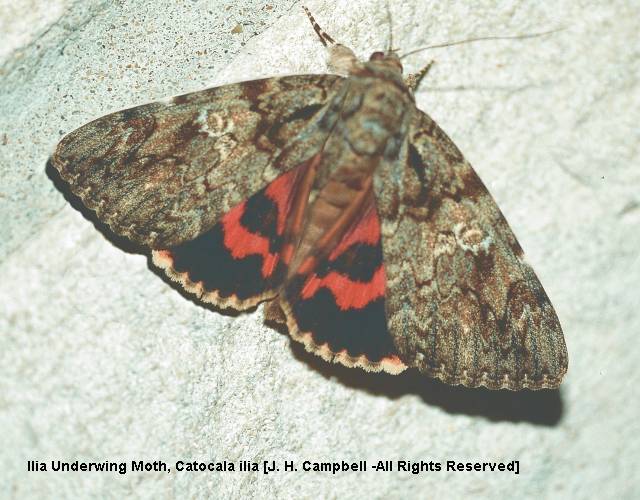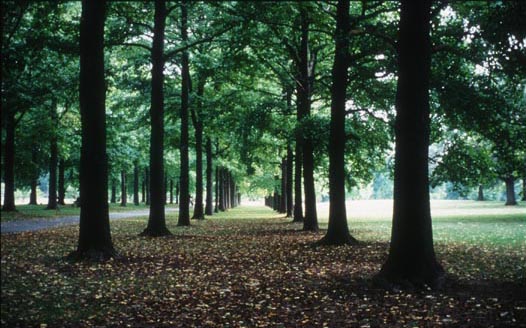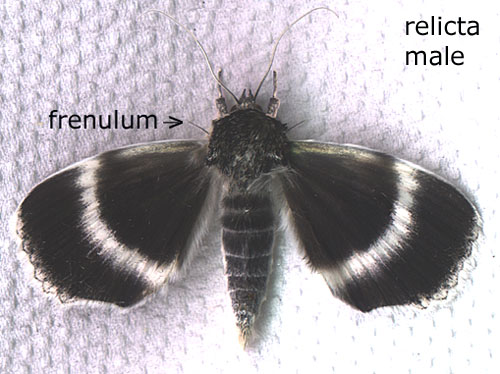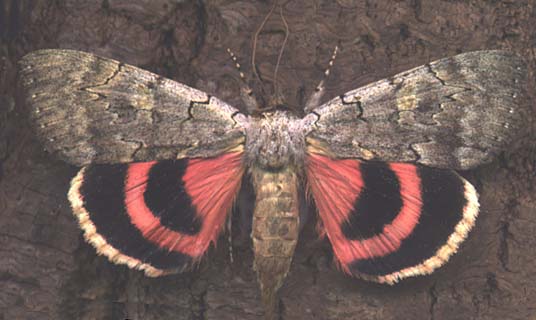


I remember, as a youngster in the 1950's, walking into a groove of magnificent trees (I believe they were oaks) in Warinanco Park in Roselle, New Jersey, to enjoy the cool shade.
My mother had taken me and two of my younger sisters to feed the ducks on the lake and enjoy the beauty of the park's open spaces and greenery.
I don't remember the trees in rows as depicted in this recent (2000) image, but the shade surrounded by bright open space still brings back old memories.

I scarce had entered the grove when a large Catocala species with striking red underwings startled me. I froze in my tracks. I think it was Catocala ilia as they are large, feed on oaks in larval stage and have brilliant red lower wings.
The moth didn't fly far and seemed to miraculously disappear into the shade beneath the foliage a few trees further down. I moved quickly to the tree where it seemed to have landed and was about ten feet from the bole when another flash of red stopped me.
I was up for the game of chase, probably nine or ten years old at the time, and wanted to get a closer look. There were several specimens in the grove and I frequently got surprised. Before long I realized a slow, quiet approach was necessary to avoid the moth's undesired response. The Catocala have an acute sense of hearing via the tympanum on the side of the metathorax, pointing toward the rear, just below the hindwing juncture.
Only a few times did I get close enough to see the well-camouflaged moths resting on the bark. With their hindwings completely concealed by their dark, mottled forewings, it was hard to pick them out on the rough grey background.
When I was twelve, my family moved from Roselle to Pottersville, New Jersey. The move to the country was exciting with the river, the woods, and all the wildlife.
During one of my daytime expeditions I encountered a group of anglewings and underwings feeding on fermenting tree sap. A white foamy ooze with a sweet smell that even I could detect was attracting the insects in good number. The moths and butterflies were feeding about two feet from the ground on the trunk of a large oak. Like the butterflies, the Catocala have a feeding tube or proboscis for nectaring at flowers or feeding from tree wounds or on fermenting fruit.
There were several species enjoying the sweet sap. Little yellow underwings seemed more common than the bigger red ones.
A few years later, in my early teens, I was amazed at the dexterity and knowledge of Joe Muller, one of my father's friends. Joe would often come to the house with a "sugaring" mix, a few empty jars, some glassine envelopes, a flashlight and paintbrush and a small collecting net.
He and my father enjoyed chatting and inspecting the night visitors at the black light mounted on the river side of the house.
At dusk, the three of us would go out to "paint trees" with Joe's mix, a sweet smelling concoction of brown sugar, stale beer and over-ripe fermented bits of peaches and other fruit.
Every hour or so we would tour the trail of painted trees looking for Catocala. Most stops provided at least one interesting specimen.
Joe was particularly adept at capturing any moth in his net, carefully extracting it and then quickly sexing it by inspecting the frenulum to determine the sex.He would deftly part the wings with his fingers (no harm to the moth) and with a flashlight in his mouth determine if the frenulum consisted of a single spine signifying a male or a multiple structure signifying a female. Catocala relicta male, by Bill Oehlke. | 
|
Most species he could identify at a casual glance, but others he examined very carefully, looking at leg structures and ventral hindwing patterns before offering a verdict.
My father's main interests at the time revolved around the giant silkmoths indigenous to our area. Their normal flight season ended in August. It was interesting to learn that Catocala females lay eggs on tree bark and the eggs overwinter, with tiny larvae emerging in the warmth of spring and early summer. Hence, our expeditions continued at least until late September.
I was busy with school and sports throughout my teen years and have only recently returned to a "study" of the Catocala.
I am able to gather specimens (August to September) at the 175 watt mercury vapour light on my rooftop and currently have a "recipe" for sugaring "brewing" in a ziploc bag.
I hope to share what I learn via the images and info on this site. The concumbens and relicta and other species indigenous to the Island amaze me with their sriking patterns and colours.

As I gain experience rearing members of this genus, I will post the knowledge accrued.
Return to Main Index
|

|